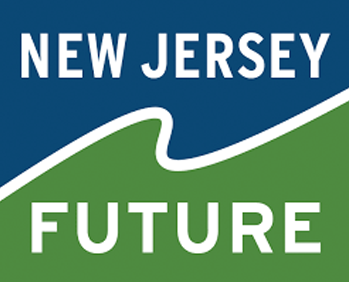
What is Green Infrastructure?
The term “green infrastructure” or “green stormwater infrastructure” refers to a set of stormwater management practices that use or mimic the natural water cycle to capture, filter, absorb, and/or reuse stormwater.
The NJDEP defines it more technically as a stormwater management measure that manages stormwater close to its source by:
- Treating stormwater runoff through infiltration into subsoil;
- Treating stormwater runoff through filtration by vegetation or soil; or
- Storing stormwater runoff for reuse.
Unlike traditional gray infrastructure, green infrastructure integrates high-performance landscapes and hardscapes to meet stormwater requirements while also improving the appearance and value of your project. Though most commonly understood as garden-like landscapes, green infrastructure can also be installed on roofs or in paved areas. The NJDEP refers to approved green infrastructure techniques as Best Management Practices, or “BMPs.”

The Hydrologic Cycle
Image Credit: Environmental Protection Agency, Washington D.C., 2018
Effect of Impervious Cover on Stormwater Runoff
In a natural environment, rainfall is cycled through the process of evaporation, uptake by plants, and infiltration into the ground. Development (roofs, pavement, etc.) disrupts this process and leads to runoff and water pollution.
What does green infrastructure do?
Green infrastructure can be used to meet Water Quantity, Water Quality, and Groundwater Recharge requirements. When selecting green infrastructure practices for a site, developers should consider the different functions of each BMP. Each requirement varies based on specific site conditions and the intensity of development.
- Water quantity requirements involve capturing, storing, slowing, and/or infiltrating stormwater runoff.
- Water quality requirements involve removing pollutants conveyed by stormwater runoff.
- Groundwater recharge requirements ensure that underground aquifers are replenished through deep infiltration.
How do you measure Water Quality?
The NJDEP measures Water Quality through reductions in Total Suspended Solids (TSS). TSS in stormwater are commonly found in the forms of rock and soil fragments and debris. Green infrastructure can remove these and improve Water Quality for local ecosystems.
What are some key considerations?
- Separation from Groundwater is an important design consideration. Before proceeding with design, soil testing is required to determine if selected locations have the required separation from the seasonal high water table. If separation is not maintained, groundwater can interfere with proper drainage, resulting in system failure. Each BMP has specific requirements for separation.
- Soil Conditions are crucial to green infrastructure design. Soil hydraulic conductivity testing should be performed early in the design process to determine that infiltration is possible.
- Drainage Areas for each BMP should also be considered. The new NJDEP stormwater rules codify a decentralized approach to stormwater management, so that stormwater BMPs are distributed around a site. The rules assign maximum contributory drainage areas to the BMPs, as shown in the three tables discussed in the following section. If the proposed BMP would collect runoff from a drainage area larger than NJDEP regulations allow, a different BMP may be necessary.
- Maintenance should be considered early in the design process. Developers must think about maintenance requirements for the selected BMP and how that maintenance will be ensured. Engineers must provide access to BMPs in their designs to facilitate these efforts.
How do you know which green infrastructure practices are approved?
The new NJDEP stormwater rules organize Best Management Practices (BMPs) information into three tables: 5-1, 5-2, and 5-3. Table 5-1 includes BMPs that can be used to meet water quality, recharge and quantity requirements. Table 5-2 includes BMPs that are approved for water quantity management and, with a waiver or variance, for water quality and recharge. Table 5-3 includes BMPs that can be used to meet all three standards (quality, quantity, and recharge), but only with a waiver or variance. To avoid the costs and headaches of seeking a variance, developers and engineers should endeavour to meet stormwater requirements using BMPs from Table 5-1 and, if necessary for overflow quantity, Table 5-2.
Various exceptions to the use of different BMPs are outlined in the new stormwater rules. Asterisks (*) in the table indicate that exceptions or limitations exist. BMPs that appear in multiple tables are differentiated by specific design requirements or site conditions. See N.J.A.C. 7:8 for further information.
The following section provides descriptions of the different “Best Management Practices,” or BMPs, outlined in the new NJDEP stormwater rules. Most, but not all, of these BMPs qualify as green infrastructure. Those that are not green infrastructure may be used only with a variance. Each practice has its own design, cost, and maintenance requirements. For additional guidance, see the NJDEP BMP Manual.
The following BMPs are included:
Bioretention System
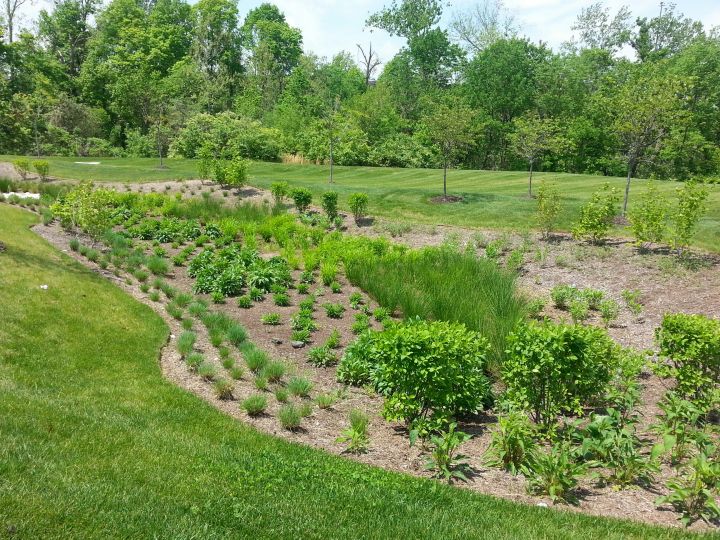 Image Credit: Bluegrass Landscaping & Maintenance, 2018
Image Credit: Bluegrass Landscaping & Maintenance, 2018Bioretention systems are vegetated depressions in the landscape designed to infiltrate stormwater into the subsoil, and/or hold it for a period of time to settle out pollutants and allow some uptake by plants. Bioretention basins can be sited in a wide range of different locations and settings. The terms “rain gardens” and “stormwater bumpouts” are often synonymous with bioretention systems. By co-locating stormwater management with visually appealing landscaped areas, designers can maximize the remaining area available for building.

Bioretention basin section view.
Image Credit: Canyon Region Water Authority, 2018
Considerations: The size of the area draining to the system can influence its effectiveness at providing water quality treatment and groundwater recharge. Small-scale bioretention systems are preferred for meeting these standards.
Cost: Bioretention systems require regular maintenance to maintain their functional and aesthetic value. Designers can lessen the degree and complexity of the required maintenance regime through careful consideration of the soil specification and use of native plants. Maintenance costs can be offset by lower upfont construction costs as bioretention systems are typcically smaller than equivalent traditional detention systems.
Maintenance: Bioretention systems require frequent inspections, debris and sediment removal, and landscape services for vegetation management.
Blue Roof
 Image Credit: NYC Department of Environmental Protection, 2018
Image Credit: NYC Department of Environmental Protection, 2018Blue roofs are non-vegetated systems that hold stormwater. They can be designed as modular trays with loose stones, specialized permeable pavers, or just a waterproof membrane.
Benefits include:
- Better temperature regulation on the roof surface
- Lower building heating and cooling costs
- Minimizes land used for stormwater management, allowing for more recreational and public space area

Blue Roof with Pedestal Pavers Image Credit: Hydropavers, Inc., 2018
Considerations:
- Blue roofs are only suitable for flat roofs.
- Blue roofs can be modified onto existing roofs.
- Rooftops must be evaluated for structural considerations before a blue roof can be installed.
Cost: Blue roofs are generally less costly than green roofs due to the lack of soil and vegetation components. Blue roofs can reduce the size of downstream BMPs, saving cost throughout the stormwater design. No excavation or earthwork is required.
Maintenance: Regular maintenance activities include inspections, debris/ sediment removal, and breaking up ice in winter months.

Deconstructed Blue Roof
Image Credit: Hudson Roofing, 2018
Cistern
 Image Credit: Environmental Finance Center, 2018
Image Credit: Environmental Finance Center, 2018Cisterns are storage tanks designed to capture and store stormwater for non-potable uses such as irrigation, toilet flushing, or industrial processes. Stormwater runoff is typically carried from roof areas to cisterns through roof gutters, downspouts, drains, and/or pipes. Screens on gutters and downspouts filter large sediment and debris from stormwater runoff before it enters the rain barrel or cistern.
Considerations:
- Ensure a stable path for overflows since cisterns are not typically designed for large storms.
- Underground cisterns may need special permits, and the location for overflows may also need approvals. Check with your local municipality.
- A number of pollutants can be deposited on roofs and in parking lots. Therefore, cistern water should never be consumed without proper treatment.
Cost: Cost varies by size of cistern. Cisterns are generally more expensive per gallon of water captured compared to other BMPs. They are ideal for smaller projects where roof capture is desired. Depending on their size, cisterns can provide a significant opportunity to use recycled rainwater in place of potable water, which can help save on your project’s long-term water use costs.
Maintenance: Regular maintenance activities include flushing, filter cleaning, and debris removal. See manufacturer guidelines for specific procedures.

Aboveground Cistern Schematic
Image Credit: NJ BMP Manual, 2020
Dry Well
 Image Credit: Earth Stone and Water, 2018
Image Credit: Earth Stone and Water, 2018A dry well is a subsurface stormwater facility consisting of either a structural chamber or stone filled excavation that is used to collect and temporarily store stormwater runoff from rooftops. The dry well inflow is connected by roof leaders. The sides and top of the dry well are completely lined with filter fabric to avoid fines clogging the system.

Dry well detail.
Image Credit: Montgomery County, Maryland, 2018
Considerations:
- Dry wells are only intended for small storm events, and all excess stormwater must be designed to bypass the structure.
- Designers must ensure that soil conditions are suitable for infiltration.
Cost: Dry wells can be less expensive than other BMPs. However, under the new rules, dry wells may only be used to satisfy groundwater recharge requirements. If the project must meet water quality and water quantity standards, a BMP with the capacity to provide multiple benefits should be considered.
Maintenance: Regular maintenance activities include inspections for clogging and structural damage and sediment and debris removal. Roof drains should be checked and cleared regularly to prevent upstream clogging and to ensure that water reaches the system.
Extended Detention Basin
 Image Credit: Princeton Nature Notes, 2018
Image Credit: Princeton Nature Notes, 2018Extended detention basins are surface depressions that temporarily store stormwater runoff. The slower drain time allows sediment to settle to the basin bottom before water discharges. The amount of water quality treatment is dependent upon the detention time.

Extended detention basin detail.
Image Credit: NJ BMP Manual, 2018
Considerations: Sediment will accumulate at the basin bottom. Designing systems to accommodate more volume than required can accommodate for this volume loss.
Cost: Extended detention basins are generally less expensive per square foot than infiltration basins or bioretention basins due to the lack of planting and soil modifications/amendments. However, they have less benefit per square foot and are likely to require larger footprints to manage water quality and water quantity. Detention basins need to be paired with additional BMPs to achieve groundwater recharge on site and/or water quality rates over 60%.
Maintenance: Regular maintenance activities include inspections for structural damage related to the inlet and outlet structures, ponding within the basin, and the structural integrity of the berm and spillway. Frequent mowing and clearing of debris/sediment is also required.
Grass Swale
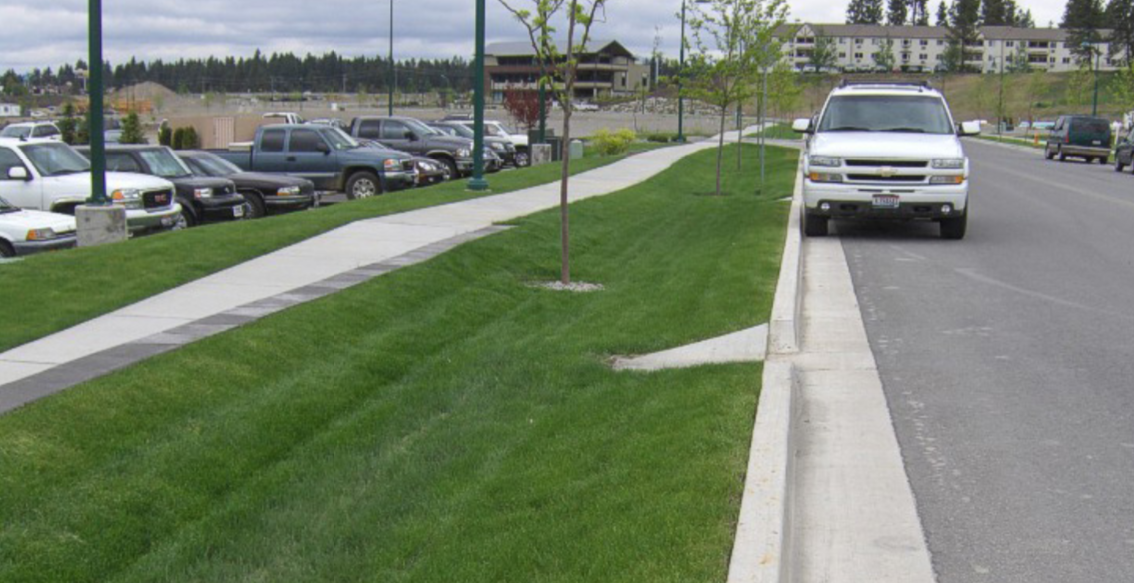 Image Credit: Keltic Engineering, Inc., 2018
Image Credit: Keltic Engineering, Inc., 2018A grass swale is a long, narrow grassy channel used to convey stormwater to a downstream green infrastructure practice or storm drain. Grass is typically kept to a height of about three to six inches to slow down the runoff and allow any debris or sediment to settle out without interfering with the direction of flow. Depending on site conditions, additional features such as check dams and underdrains may be required to comply with New Jersey Soil Erosion and Sediment Control Standards.

Grass Swale Diagram
Image Credit: NJ BMP Manual, 2018
Considerations: The stability of grass swales needs to be considered during the design process. High velocities and steep slopes can lead to erosion issues.
Cost: Grass swales are typically more affordable than traditional piping. Maintenance costs are relatively low.
Maintenance: Grass swales are easily maintained through regular mowing and debris removal.
Green Roof
 Image Credit: Andropogon, 2020
Image Credit: Andropogon, 2020A green roof is a system of lightweight soil and plants. The plants absorb some of the rain that falls on the roof, and any excess is stored in a soil layer below. Layers of soil and plants are as thin as just a few inches or as thick as several feet depending on the structural capacity of the roof and the types of plants that are specified. Roofs with a thin soil layer are lighter and easier to install, and are usually planted with succulents that need minimal water and nutrients to survive. Green roofs with thicker soil profiles can support a greater variety of plants, including trees and shrubs, but are more expensive.
Benefits include:
- Better temperature regulation on the roof surface
- Minimizes land used for stormwater management, allowing for more recreational and public space area

Deconstructed Green Roof
Image Credit: Mekobre, 2018

Paseo Verde Green Roof
Image Credit: Zelen Architecture, 2018
Considerations:
- The structural capacity of an existing or proposed roof should be considered before proposing a green roof.
- Green roofs can be combined with blue roof systems to maximize the effectiveness of stormwater storage while maintaining the aesthetic and recreational value that green roofs provide.
- Green roof plant palettes should consider seasonality, wind exposure, and drought tolerance to maximize performance year-round, especially in colder weather.
Cost: Green roofs can provide cost savings for a building’s heating and cooling. Construction costs of the green roof system are generally more expensive than typical roof construction and vary based on intensity and design. Maintenance costs are similar to landscape maintenance costs with occasional mechanical upkeep.
Maintenance: Regular maintenance activities include inspections, debris and sediment disposal, and frequent vegetation management.
| Types of Green Roofs | |||
|---|---|---|---|
| Name | Vegetation | Media Depth | |
| Intensive | Supports trees and shrubs | 10 or more inches | |
| Semi-Intensive | Grasses, herbaceous perennials, and shrubs | 6-10 inches | |
| Extensive | Succulents, herbs, and grasses | 3-6 inches | |
Infiltration Basin
 Image Credit: Minnesota Pollution Control Agency, 2018
Image Credit: Minnesota Pollution Control Agency, 2018An infiltration basin captures stormwater and infiltrates it into the ground through highly permeable soil media designed to remove pollutants and promote groundwater recharge. The soils in these systems treat pollutants via settling, filtration, and biochemical activity.
Like bioretention systems and sand filters, infiltration basins are more effective at providing water quality treatment and groundwater recharge for small drainage areas. For large drainage areas, a waiver is required to use an infiltration basin for water quality and/or groundwater recharge.

Infiltration Basin
Image Credit: NJ BMP Manual, 2018
Considerations:
- The bottom surface of an infiltration basin shall be be engineered sand or other approved soil media. A minimum of six inches is required.
- No vegetation is permitted in the bottom sand surface of an infiltration basin.
- Due to the high rate of infiltration, basins are not permitted to be located in area of high pollutant or sediment loading.
- No material or equipment storage should be located within an infiltration basin during construction in order to avoid compaction.
- Upstream slopes must be stabilized before the infiltration basin is made operational.
Cost: Infiltration basins are more efficient at meeting stormwater requirements and can therefore have smaller footprints. Maintenance costs are comparable to traditional detention basins.
Maintenance: Regular maintenance activities include sediment/debris removal and inspections for structural damage, erosion, and clogging of outlet and inlet structures.
Manufactured Treatment Device
 Image Credit: Contech Solutions, 2020
Image Credit: Contech Solutions, 2020A manufactured treatment device (MTD) is a structural alternative to treating water quality on a site. This approach to treatment can be used when space is limited. MTDs are designed to remove chemical contaminants and sediment from runoff through filtration, vortex separation, and/or other technologies.

MTDs can replace traditional tree pits, optimizing the use of space on a site.
Image Credit: Contech Solutions, 2020
Considerations:
- MTDs are most effective for small drainage areas.
- Separation from groundwater must be assessed. Different BMPs require varying distances to the seasonal high water table.
- The NJDEP requires developers to select from a list of certified MTDs listed on their website.
Cost: Manufactured treatment devices are typically more expensive to install and maintain than other BMPs that treat water quality. Capital costs vary based upon manufacturer, size of treatment area, and other design considerations. Cartridge replacement for MTDs is required regularly for the entire lifespan of the device.
Maintenance: Regular maintenance activities include inspection of structural components, removal of sediment and debris, and cartridge replacement. See manufacturer guidelines for specific procedures.
Pervious Pavement System
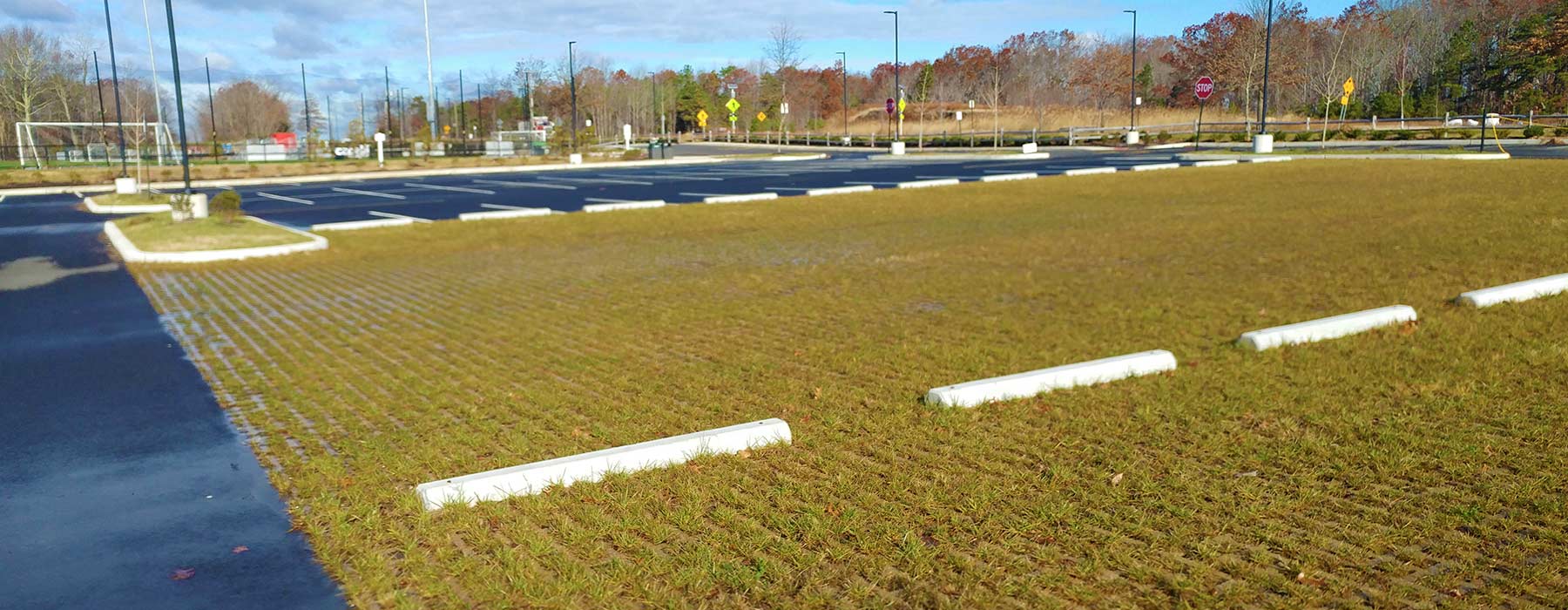
Pervious pavement is a surface that allows water to infiltrate into the ground below. Pervious pavement materials can include asphalt, concrete, interlocking concrete pavers, gravel, and resin-bonded materials such as recycled rubber, mulch, and glass. These surface courses are installed over a supporting base of crushed stone that helps to store and infiltrate stormwater.
Pervious pavements can offer a simple means of integrating green infrastructure if your development footprint is tightly constrained.

Pervious pavement systems.
Image Credit: Philadelphia Water Department Plan Review, 2018
Considerations:
- Pervious pavement is typically used in parking lot stalls or areas of pedestrian traffic. It is not recommended for drive lanes subject to heavy traffic or where nearby land uses generate heavy sediment or organic material accumulation that could clog the system.
- Construction should not take place during rain or snow, when the subsoil is frozen, or when there is significant accumulation of sediment or debris. These conditions can permanently clog the pervious pavement.
- Snow and ice, especially from areas treated with sand, should not be stockpiled on a pervious pavement system.
Cost: Infiltration systems, such as pervious pavement, are more efficient at meeting stormwater requirements and can therefore have smaller footprints. Construction costs are similar to traditional underground detention systems.
Maintenance: Regular maintenance activities include inspections and sediment/ debris removal, typically with a regenerative air vacuum.
Sand Filter
 Image Credit: Montgomery County, MD, 2018
Image Credit: Montgomery County, MD, 2018A sand filter is a depression in the ground used to capture, infiltrate, and filter pollutants before discharging. Sand filters are similar to infiltration basins in design. The primary difference is that sand filters can have vegetative cover and are less aesthetically obtrusive. Sand filters can be constructed with or without underdrains.
Like bioretention systems and infiltration basins, sand filters are more effective at providing water quality treatment and groundwater recharge for small drainage areas. The NJDEP requires a variance for sand filters with large drainage areas to count for water quality and groundwater recharge.

Sand Filter Diagram
Image Credit: NJ BMP Manual, 2020
Considerations:
- Upstream slopes must be stabilized before the sand filter system is made operational
- Construction equipment should not be placed within the sand filter in order to avoid compaction.
Cost: Infiltration systems are more efficient at meeting stormwater requirements and can therefore have smaller footprints. Maintenance costs are comparable to traditional detention basins.
Maintenance: Maintenance for sand filters requires regular raking, repair of structural components, and inspections. The sand layer will need to be removed and replaced with sediment accumulation.
Standard Constructed Wetland
 Image Credit: Philadelphia Water Department, 2020
Image Credit: Philadelphia Water Department, 2020A constructed wetland is an engineered wetland system that can be used to reduce peak flows and meet water quantity regulations. Constructed wetlands have the added benefit of removing a wide variety of pollutants through settling and vegetative filtering, providing wildlife habitat, and adding aesthetic value to a site.

Constructed wetlands diagram
Image Credit: AKRF, Inc., 2018
Considerations: The vegetation and biological processes of constructed wetlands are vulnerable to chemicals. Use of pesticides and herbicides upstream of the BMP should be avoided or used very cautiously.
Cost: Constructed wetlands generally cost more than other basins due to the high density of plant growth and excavation. However, plants in constructed wetlands require a less manicured approach than traditional landscape practices and can, therefore, cost less to maintain over the life of the system.
Maintenance: Constructed wetlands require regular inspection, maintenance of water levels, debris/sediment removal, and landscape services for vegetative areas.
Subsurface Gravel Wetland
 Image Credit: Native Plant Solutions, 2018
Image Credit: Native Plant Solutions, 2018A subsurface gravel wetland is a system containing both a subsurface gravel bed and a surface marsh. Stormwater runoff is infiltrated through the marsh into the gravel bed. The gravel bed filters pollutants and conveys water to an outlet structure.
Considerations:
- The NJDEP recommends allowing wetlands plants to establish prior to system operation.
- Liners may be necessary if soil conditions do not meet the degree of impermeability required by the NJDEP.
Cost: Subsurface gravel wetlands are generally more expensive than constructed wetlands per square foot. The gravel layer and piping requires additional excavation.
Maintenance: Subsurface gravel wetlands are similar to constructed wetlands. However, additional measures to maintain water levels and to inspect clogged piping are necessary. Subsurface gravel wetlands require regular inspection, maintenance of water levels, debris/sediment removal, and landscape services for vegetative areas.
Vegetative Filter Strip
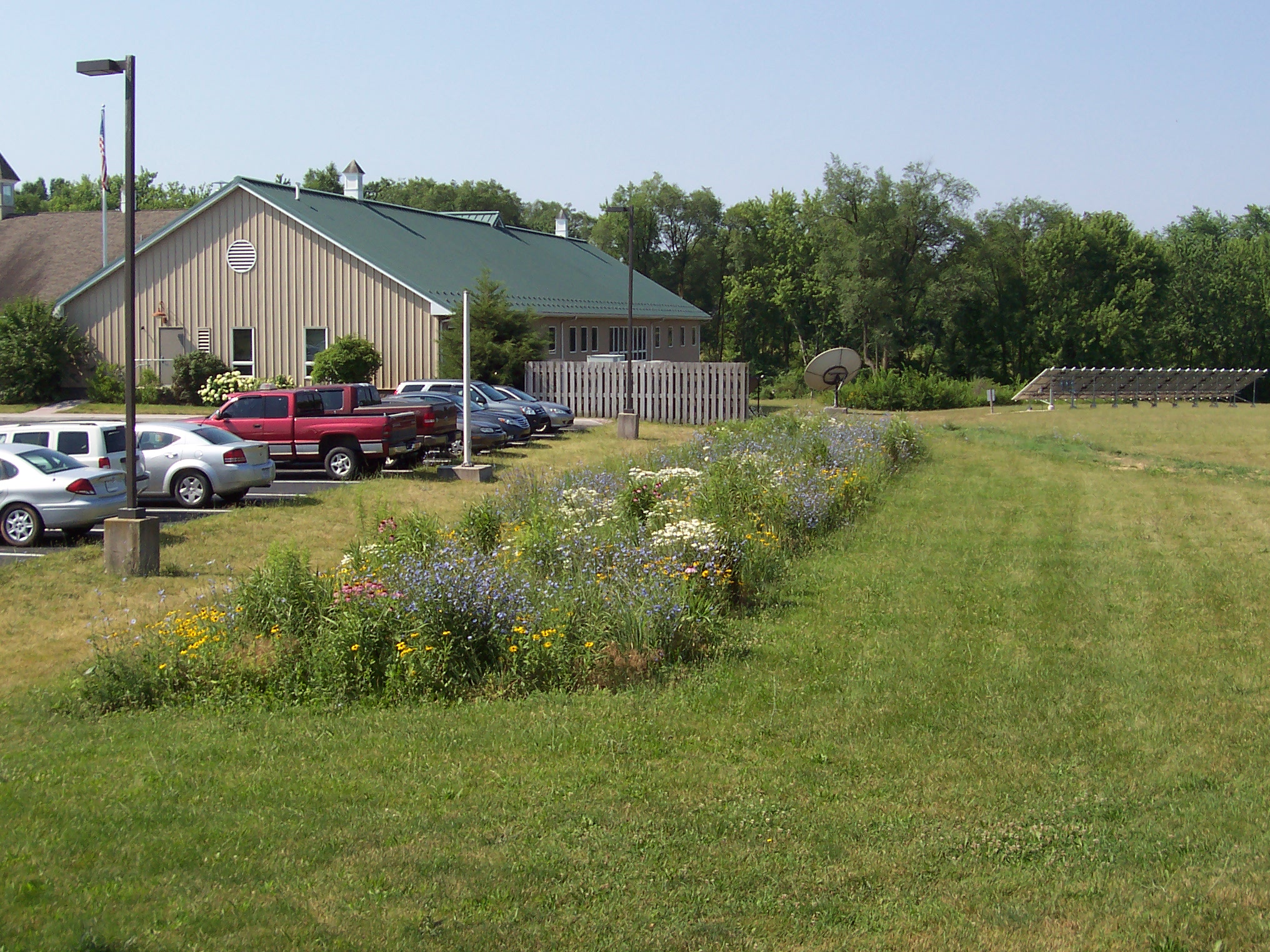 Image Credit: Adams County Stormwater BMPs, 2018
Image Credit: Adams County Stormwater BMPs, 2018A vegetative filter strip is a gently sloping landscaped area that provides pretreatment to an adjacent stormwater management facility. The BMP slows the upstream runoff rate, reducing the risk of erosion and allows for quicker infiltration before the water leaves the site. Vegetative filter strips add visual buffer from impervious areas such as parking lots.

Considerations:
- Vegetative filter strips are not bioswales. Runoff must be flowing in the form of sheet flow (not concentrated flow like in a swale or pipe) across the vegetative filter strip in order for this green infrastructure practice to be effective.
- The type of vegetative groundcover specified affects the level of water quality treatment which can be achieved. For instance, woodland plant species provide 70% TSS removal while turf grass provides 60% removal.
Cost: Vegetative filter strips are relatively inexpensive compared to other BMPs. A filter strip can be designed using existing vegetated areas or newly proposed planted areas.
Maintenance: Maintenance varies based upon composition of the filter strip. Regular maintenance activities may include debris/sediment removal, mowing, and landscape services.
Wet Pond
 Image Credit: Native Plant Solutions, 2018
Image Credit: Native Plant Solutions, 2018A wet pond is a permanent pool where stormwater is captured and regulated by an elevated outlet structure. Native vegetation should be used to provide a permanent buffer around the pool. Water from the pond should be used for irrigation or some other beneficial use.
Wet ponds are used to accommodate runoff and provide stability from larger design storms. They can also be used when wildlife habitats, recreational benefits, or water supply for irrigation or fire protection need to be enhanced. Wet ponds may look similar to constructed wetlands, but their plantings, soil, and subsurface systems are very different.

Wet Pond Diagram
Image Credit: NJ BMP Manual, 2018
Considerations:
- Use of wet ponds under Table 5-2 requires a 10-foot-wide area of native vegetation along at least 50% of the shoreline.
- Safety ledges are required around wet ponds deeper than 3 feet.
Maintenance: Regular maintenance activities include inspections, sediment/ debris removal, and landscape services for vegetated areas. The forebay must be cleaned once 6 inches of sediment have accumulated.
